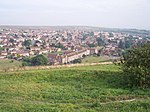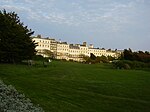Whitehawk
Areas of Brighton and HoveEngvarB from October 2013Hill figures in England

Whitehawk is a suburb in the east of Brighton, England, south of Bevendean and north of Brighton Marina. The area is a large, modern housing estate built in a downland dry valley historically known as Whitehawk Bottom. The estate was originally developed by the local council between 1933 and 1937 and included nearly 1,200 residences. Subsequently, the Swanborough flats were built in 1967, and in the 1970s and 1980s much of the estate was rebuilt by altering the road layouts and increasing the number of houses. Whitehawk is part of the East Brighton ward of Brighton and Hove City Council.
Excerpt from the Wikipedia article Whitehawk (License: CC BY-SA 3.0, Authors, Images).Whitehawk
Camber Close, Brighton Whitehawk
Geographical coordinates (GPS) Address Nearby Places Show on map
Geographical coordinates (GPS)
| Latitude | Longitude |
|---|---|
| N 50.824 ° | E -0.105 ° |
Address
Camber Close
Camber Close
BN2 5LZ Brighton, Whitehawk
England, United Kingdom
Open on Google Maps










